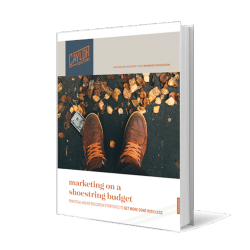Enrollment as a Turnaround Strategy: Leading a Proactive Recovery in Higher Ed
How Bethany College used enrollment as a turnaround strategy to overcome a $5M crisis—shifting from crisis management to mission-driven growth.
Future of Higher Ed
AI literacy is quickly becoming the new baseline for workforce readiness, just as digital literacy once was with tools like Microsoft Office and later the Adobe Creative Suite. Yet for many colleges and universities, innovation has always felt just out of reach.
Tradition runs deep, and risk-taking feels uneasy.
But higher ed innovation is not an option or a luxury. It’s an essential practice for staying relevant in a world transformed by technology and student expectations.
So how can schools that typically move slowly, and even sometimes resist change, create an environment where AI literacy and digital fluency thrive?
The answer might be found in an unexpected place.
Community colleges, often underestimated, are leading the way.
Butler Community College has become a model for what happens when institutions choose to listen to students and meet them where they are, preparing them not only for today’s academic success but also for tomorrow’s AI-driven workplace.
Colleges and universities, often steeped in tradition and cautious in their approach, aren’t typically recognized as hotbeds of risk-taking. However, to stay relevant, higher ed innovation is going to be more important in today’s fast-paced and ever-evolving world.
So how are schools like Butler Community College creating a culture of innovation?
It starts with listening.
In this The Higher Ed Marketer podcast episode, Butler’s president, Dr. Kimberly Krull, and Director of College Relations and Marketing, Kelly Snedden, explained how their commitment to student forums became the foundation of meaningful change.
About every month I hold a student forum with our students on both of our campuses. I asked the students, “Tell us what worked well in the middle of all of this?”
[The students] were honest. The thing that shone through all those conversations is, “Keep the technology! We want the flexibility of classroom technology. We need the flexibility in our scheduling, because they’re working multiple jobs.”
They were and still are struggling with childcare. They’re driving back and forth [from the campus]. They’re juggling finances, and all those kinds of things.
And so we really have worked hard to embed some unique technology.
The students’ input reshaped the way Butler thought about classrooms, technology, and the student experience—setting the stage for broader innovation.
One of Butler’s most visible innovations happened when it became the 50th Adobe Creative Campus in the nation.
This designation gave students, faculty, and staff access—free of charge—to the full Adobe Creative Suite platform, both on and off campus.
Students quickly embraced these tools as part of their everyday learning. Whether they were editing video, creating presentations, or designing social media graphics, the Adobe suite became part of their academic toolbox.
As a higher ed marketer, you might recognize how essential these creative platforms have become. Just as Microsoft Office once set the standard for professional literacy, Adobe’s tools are now considered core skills across many industries.
By embedding digital literacy into the student experience, Butler prepared its graduates to stand out in a marketplace where creativity and communication are more important than ever.

With generative tools like Adobe Firefly, ChatGPT, and Canva AI shaping professional communication, the line between creativity and AI collaboration is quickly blurring.
For Butler, the path forward is clear: equipping students with these skills is not just innovation. It’s preparation for the future of work.
Just as learning Word and Excel became non-negotiable twenty years ago, and mastering the Adobe suite became essential in the past decade, AI literacy is now emerging as the next baseline skill for students entering the workforce.
Employers increasingly expect graduates to know how to collaborate with AI, whether it’s generating a first draft in ChatGPT, enhancing design work in Adobe Firefly, or using Canva AI to streamline social media campaigns.
For higher ed institutions, this shift means going beyond access to digital tools.
It requires teaching students how to prompt effectively, critique AI-generated output, and apply these tools ethically in real-world contexts.
At Butler, the same student-first mindset that fueled digital literacy initiatives could easily be applied to AI literacy.
By listening to what students are already using and where they struggle, colleges can ensure their graduates are not just consumers of technology but leaders in an AI-driven world.
It would be easy to focus only on Butler’s achievements and forget how they got there. As I touched on earlier, their innovations didn’t begin with technology.
The innovations on Butler’s campus began with conversations.
These ongoing forums gave students the chance to share needs that went beyond academics: balancing jobs, childcare, transportation, and finances.
Their feedback directly inspired solutions like high-flex classrooms, border-to-border Wi-Fi, and the “My Laptop” initiative, which allowed students to purchase affordable laptops and keep them after graduation.
One of the other things we had utilized during the pandemic was Zoom, trying to help students and faculty connect remotely.
Because you never knew whether you [were going to] have family members at home that were sick…
So we’ve continued to build out some classrooms on campus that we call ‘high flex classrooms’ that have capabilities.
For a majority of Butler’s students—60% of whom are part-time—these innovations provided flexibility and access that directly supported persistence and completion.
In the same way, colleges today can apply this approach to AI literacy: listening first, and then implementing creative solutions where they most directly improve student success.

Higher ed innovation doesn’t start with chasing trends or copying competitors.
It starts with listening to students, understanding their challenges, and designing solutions that align with their lived realities.
You can see that so clearly in Butler Community College’s story.
Their efforts in digital literacy, flexible classrooms, and expanded access were never about technology for its own sake.
They were about serving students better.
AI literacy adds a new layer to this principle. Students are already using generative AI in their personal and academic lives.
Colleges that guide them toward ethical, effective, and mission-aligned use of these tools will be the ones preparing graduates for long-term success.
The lesson is simple but complex.
Authentic innovation means walking alongside students, listening carefully, and building systems that help them thrive in a rapidly changing world.
🎧 For even more insights from Dr. Kimberly Krull and Kelly Snedden, listen to the full episode on The Higher Ed Marketer podcast.
Training and Staff Development: Custom AI Masterclass
Just as Butler demonstrated that authentic innovation begins with students, real institutional change happens when your team is prepared to lead it.
That’s why we offer a Custom 6-hour AI Masterclass designed specifically for higher ed teams.
Over the course of two sessions, we cover AI best practices, prompt design, and the most effective AI tools for marketing and enrollment.
Then we roll up our sleeves together, workshopping real use cases straight from your institution. By the end, your staff won’t just understand AI literacy in theory—they’ll be equipped to apply it immediately in ways that serve your students and advance your mission.
If you want to give your team the confidence and clarity to lead with AI, our Custom AI Masterclass is the perfect next step.
Contact us today to find out more about hosting an AI Masterclass in your school.
Set yourself free from your shrinking marketing budget with my popular ebook Marketing on a Shoestring Budget! This ebook is jammed with practical ways to produce high-quality marketing on the cheap.
Inside, I’ll show you proven marketing tactics like…
No hype. No pie in the sky. Just real solutions for getting the job done with the budget you’ve got.
Featured image via butlercc.edu
Other images via Midjourney
Subscribe to The Higher Ed Marketer podcast today!